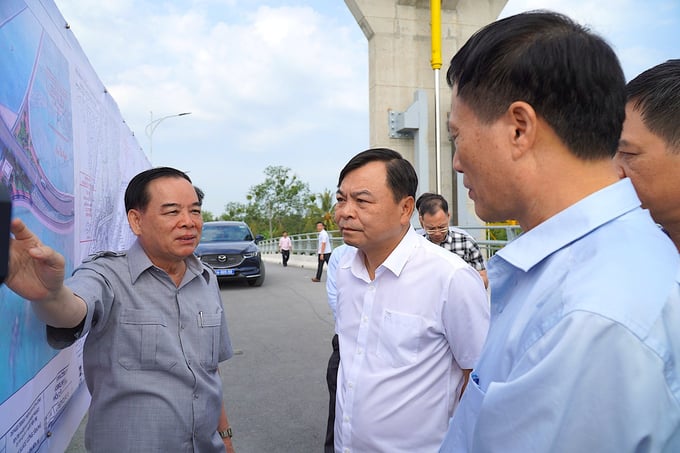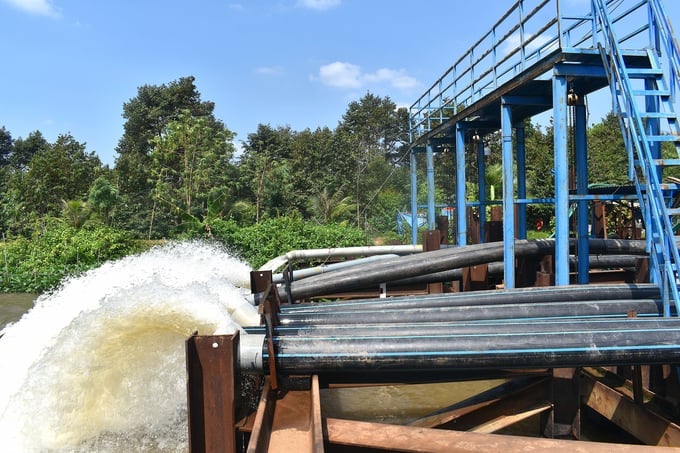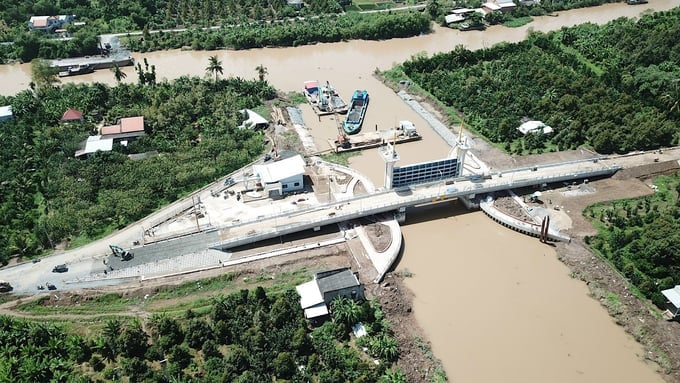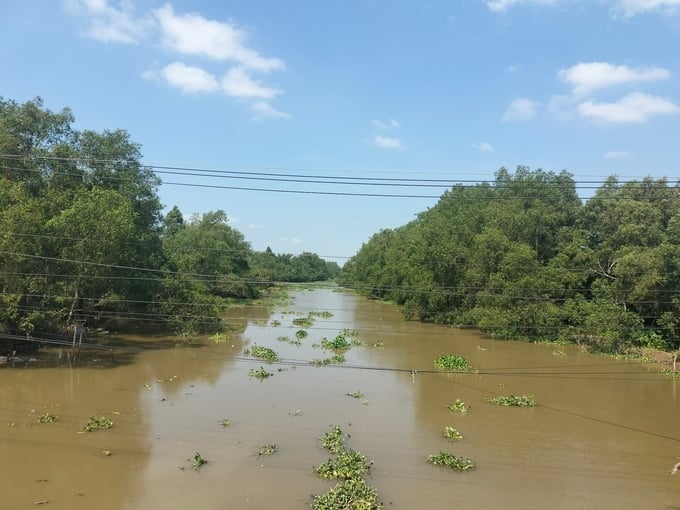May 26, 2025 | 07:33 GMT +7
May 26, 2025 | 07:33 GMT +7
Hotline: 0913.378.918
May 26, 2025 | 07:33 GMT +7
Hotline: 0913.378.918
Editor's note: Amidst the peak of salinity drought in 2024 in the Mekong Delta, the region's sewer system and irrigation works have proven highly effective upon implementation. Reporters from the Vietnam Agriculture Newspaper ventured into the heart of the drought and salinity, capturing firsthand accounts and witnessing remarkable transformations in project areas.
Throughout the dry season of 2023-2024, in the northern region of Chau Thanh district, Ben Tre province, the Ministry of Agriculture and Rural Development (MARD) initiated and operated two salinity regulation projects: the Tan Phu sluice gate (located in Tan Phu commune) and the Ben Ro sluice gate (in Tien Long commune). The operation of these projects has successfully prevented saltwater intrusion from the Tien River and Ham Luong River into the upstream of Ba Lai River, ensuring a fresh water supply to numerous households and extensive hectares of fruit orchards in the North Chau Thanh area and Ben Tre city.

Mr. Tran Ngoc Tam, Chairman of the Ben Tre Provincial People's Committee, discusses the effectiveness of the Tan Phu and Ben Ro sluice gate projects with Deputy Minister of Agriculture and Rural Development Nguyen Hoang Hiep, proposing swift completion of the JICA3 project to aid local water source management. Photo: Minh Dam.
During the 2019-2020 dry season, Tan Phu commune suffered severe saltwater intrusion from both the Ham Luong River and the Tien River, affecting the upstream of the Ba Lai River.
Hence, the local government and residents proactively dredged canals and garden ditches in this equally harsh dry season to maximize freshwater storage.
Additionally, the Tan Phu sluice gate project was activated, instilling a sense of security among the populace. Presently, fruit farmers have taken proactive measures, sealing off reservoirs and utilizing water stored in garden ditches to combat drought.

The Tan Phu sluice gate effectively blocks salinity intrusion from the Tien River into the upstream of the Ba Lai River. Photo: Minh Dam.
Mr. Le Sanh Quyen, a farmer owning 2 hectares of durian trees aged 3-6 years in Tan Nam hamlet, Tan Phu commune, diligently stays updated on saltwater intrusion and drought information through media outlets and local announcements via Zalo and the commune loudspeaker. Three months ago, he invested in hiring a Kobe machine to excavate a pond spanning 1,000 square meters and 5 meters deep, capable of storing over 3,000 cubic meters of water.
Mr. Le Sanh Quyen, a farmer owning 2 hectares of durian trees aged 3-6 years in Tan Nam hamlet, Tan Phu commune, diligently stays updated on saltwater intrusion and drought information through media outlets and local announcements via Zalo and the commune loudspeaker. Three months ago, he invested in hiring a Kobe machine to excavate a pond spanning 1,000 square meters and 5 meters deep, capable of storing over 3,000 cubic meters of water.
During this drought season, he has taken proactive measures to economically irrigate his durian orchard by employing rain spraying techniques, providing 80 liters of water per root per day. Additionally, he purchases straw to mulch the roots of young durian trees and maintains grass in large orchards to minimize water loss. With the water stored in the pond, he assures it will suffice for nearly 3 months, ensuring his durian orchard withstands this year's drought and salinity challenges.
"Currently, owing to the Tan Phu sluice gate, salinity levels in the sluice are lower than those in larger rivers, and water levels in the canals are maintained, preventing depletion of water in the garden ditches. Thus far, I haven't had to tap into the water stored in the pond. Compared to the salty season of 2019-2020, I feel much more secure this year," Mr. Quyen expressed.

Mr. Tran Van Ut Tam, the head of the Tan Phu Commune Community Extension Group, ensures regular monitoring of river salinity levels and alerts farmers to conserve water. Photo: Minh Dam.
Mr. Tran Van Ut Tam, the head of the Tan Phu Commune Community Extension Group, highlights that the recent activation of the Tan Phu sluice gate has significantly contributed to shielding the upstream of the Ba Lai River from saltwater intrusion originating from the Tien River. The agricultural extension team has actively disseminated information and mobilized locals to dredge sediment from ditches, lay tarpaulins for water storage, and promote water-saving irrigation practices.
"We routinely inspect the salinity levels in people's ditches and rivers to advise on water intake. With the low salinity in the canal, our concerns are minimized," Mr. Ut Tam remarked.
Presently, the salinity levels outside the Tan Phu sluice gate range from 0.7 to 0.9‰, while within the sluice gate, it falls between 0.25 to 0.5‰, which is suitable for daily activities.
Mr. Tran Duy Tan, Deputy Director of Hoang Tam Domestic Water Supply Company Limited (located in An Khanh commune, Chau Thanh district), mentioned that the company operates three water supply stations in Chau Thanh district, each with a capacity of 100m3 per hour. If necessary, the capacity can be increased to 150m3 per hour.
“Thanks to the Tan Phu and Ben Ro sluice gates preventing salinity intrusion, the water pocket at the headwaters of the Ba Lai River still maintains its purity. Currently, the salinity of water from the Ba Lai River ranges from 0.2 to less than 1‰, ensuring a safe supply for people's daily needs," Mr. Tan stated.
At the Thanh Trieu Commune Water Supply Station of Hoang Tam Water Supply Company, the net water salinity stands at 0.4‰, while the full water salinity measures 0.5‰.
Mr. Pham Huu Tri, an official at the station, added: "We have a temporary dam constructed by the province here at Thanh Trieu, with provincial officials on duty round-the-clock to monitor the water. Continuous pumping of water into the dam has lowered the salinity of the Ba Lai River. Additionally, transport barges are available for additional pumping during periods of high river salinity."

Pumping fresh water from the Ba Lai River into the Thanh Trieu temporary dam provides raw water for water plants. Photo: Minh Dam.
According to Mr. Pham Quoc Phong, Director of Ben Tre Province Irrigation Company Limited, the entire province's irrigation system currently meets the water needs of people in closed areas.
Although the North Ben Tre irrigation system is not fully closed yet, the company also has a flexible operation plan. The protective structures for the province's freshwater lakes, namely Tan Phu and Ben Ro sluices, have been used to store water.
The salinity outside the Tan Phu sluice has increased to 0.5-0.6‰. The company has collaborated with the Management Board of Irrigation Investment and Construction Project 9 and the Ministry of Agriculture and Rural Development to close the sluice, preventing saltwater intrusion from upstream of the Ba River and returning it to the An Hoa River. The project has effectively enhanced Ben Tre Lake's protection, serving the city's domestic water needs and industrial zones.
"Last year, with central investment supporting the North Ben Tre project, South Ben Tre met the needs of some areas. However, three sluices – An Hoa, Ben Tre, and Thu Cuu – have not been constructed in the North Ben Tre area. It is recommended that we invest in this area," said Mr. Pham Quoc Phong.
The Tan Phu and Ben Ro sluice gate projects, crucial for preventing salinity, are situated upstream of the Ba Lai River. These projects are part of the Ben Tre Water Management Project (JICA 3 Project) funded by the Irrigation Construction Investment Project Management Board 9. The total investment for these projects exceeds 295 billion VND, financed through loans from the Japanese Government.
Tan Phu and Ben Ro sluice gates share the same hydraulic works system design, featuring gates 20 meters wide and 7 meters high, along with a 6-meter-wide road. Additionally, the Tan Phu sewer system has an additional pumping station housing 6 pumps with a capacity of 20m3 per second.
In the coming years, under the JICA 3 Project, investments will be made in the An Hoa lock dam sluices on the Giao Hoa River, Ben Tre sluice gates on the Chet Say River, and the Thu Cuu sluice gate in Thuan Dien commune, Giong Trom district. Once operational, these projects will seal off the Ba Lai River effectively, creating a vast freshwater reservoir to meet the project area's production and daily water requirements amidst climate change and saltwater intrusion.

The Ben Ro sluice gate prevents saltwater intrusion from the Ham Luong River into the Ba Lai River. Photo: Minh Dam.
The JICA 3 project, funded by loans from the Japanese Government, received approval from the MARD in 2017. With a total investment exceeding 6,191 billion VND, this large-scale project encompasses the construction of 8 sluices, including An Hoa sluice, Thu Cuu, Ben Tre, Tan Phu, Ben Ro, Cai Quao, Vam Nuoc Trong, and Vam Thom, across districts such as Chau Thanh, Binh Dai, Giong Trom, Mo Cay North, Mo Cay South, and Ben Tre City.
Originally slated for completion by the end of 2023, the project has thus far only completed two of the eight salinity prevention sluice projects – the Tan Phu sluice and Ben Ro sluice – with the remaining six projects yet to be constructed.
During a recent meeting on March 12 with Ben Tre province regarding drought and saltwater intrusion prevention in the 2023-2024 dry season, Deputy Minister of Agriculture and Rural Development Nguyen Hoang Hiep attributed the project delays to the impact of the Covid-19 pandemic, which slowed down the implementation of the JICA 3 project.
During the project's duration, the devaluation of the Japanese yen and the fluctuating Japanese yen exchange rate against the US dollar resulted in a loss of over 1,000 billion VND for the project.
Additionally, the escalation of material prices, particularly steel prices, has nearly doubled from the project's inception to the present, leading to an approximate increase of 1,000 billion VND in project costs.
Consequently, the project has encountered a total increase of over 2,000 billion VND, equivalent to the shortfall in capital required to construct 2 sluices: the Vam Thom sluice and the Vam Nuoc Trong sluice.

The section of the Ba Lai River passing through Thanh Trieu commune, Chau Thanh district, maintains a salinity level of approximately 0.5‰, which adequately meets the needs of daily life for residents. Photo: Minh Dam.
Deputy Minister Nguyen Hoang Hiep disclosed that the MARD and related ministries engaged in over a year of intensive negotiations with Japanese investors regarding the JICA-3 Project. Ultimately, the partners agreed to the Ministry's request to separate the Vam Thom and Vam Nuoc Trong sluices into a distinct project.
“With the approved funding, the investor has adequate resources to proceed with the remaining 4 sluices: An Hoa, Ben Tre, Thu Cuu, and Cai Quao sluices. Regarding the Vam Thom and Vam Nuoc Trong sluices, requiring over 2,000 billion VND, the Ministry will utilize domestic medium-term public investment capital from 2026 to 2030 for their implementation," Deputy Minister Nguyen Hoang Hiep announced, pledging to Ben Tre province that the Ministry of Agriculture and Rural Development will strive to complete the JICA-3 project by 2026.
Translated by Quynh Chi
/2025/05/25/4127-3-073637_820.jpg)
(VAN) Thanks to the promotion from an FAO-implemented project, vegetable production in greenhouses in Moc Chau has seen strong development, from 1.5 hectares in 2021 to nearly 50 hectares in 2024.

(VAN) FAO has recently supported USD 140,000 to implement the project 'Risk mitigation human-animal interface risks through disease control initiatives in pig farming.'

(VAN) The People's Committee of Tra Vinh province has approved an adjustment to the investment policy for the Green Hydrogen Plant project, increasing its area to approximately 52.76 hectares.
![Reducing emissions from rice fields: [2] Farmers’ commitment to the soil](https://t.ex-cdn.com/nongnghiepmoitruong.vn/608w/files/news/2025/05/05/dsc08881jpg-nongnghiep-140632.jpg)
(VAN) Clean rice cultivation model in Thuong Tan commune, Bac Tan Uyen district, is assisting local residents in achieving sustainable agriculture by substantially reducing costs, increasing productivity, and protecting the environment.

(VAN) At the conference to disseminate Resolution No. 68, AgriS introduced its digital agricultural ecosystem and reaffirmed its commitment to accompanying the Government in promoting private sector development and sustainable agriculture.

(VAN) 'Blue Ocean - Blue Foods' initiative is designed to restore marine ecosystems and establish sustainable livelihoods for local communities by cultivating a minimum of 1,000 hectares of cottonii seaweed in the first three years.
/2025/05/21/4642-3-112707_603.jpg)
(VAN) The V-SCOPE project has made direct contributions to three out of six pillars of the Comprehensive Strategic Partnership between Vietnam and Australia.